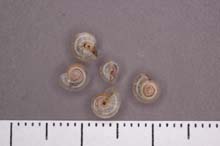
Physical Characteristics

Gastropods as a whole consist of three main parts: the mantle,
the foot, and the visceral mass (Eisenhour
et al. 2007). The mantle is a flap of
skin on either side of the body. The mantle is also the
layer which secretes the shell. In pulmonates, such as
G. rhoadsi, the mantle is specialized, containing an
air-breathing lung (Eisenhour
et al. 2007). The foot is a large mass of muscle
which is used for movement through the environment. Lastly,
the visceral mass is the body cavity which contains the internal
organs. These internal organs include a heart, intestines,
and an excretory system known as nephridia (Eisenhour et al., 2007).
As Grimm explains, G. rhoadsi has a 4.5 to 5.3 mm wide shell.
G. rhoadsi also
has a thin, translucent shell that has a glistening or shining
appearance. The shell has a helix shape to it and has 4 to 7
whorls. A whorl is one turn on the coil of the shell (The
World of Snails, 2008). G. rhoadsi has an evident
umbilicus which varies from wide to small. An umbilicus is
a hole or depression in the shell which the whorls spin around (The
World of Snails, 2008). Sculped glyphs
also have a subovate aperture, or a opening in the shell for the
body which is almost egg-like in shape. The lip, or area
around the aperture, is thin in G. rhoadsi. Their
overall color is pale yellow-brown to brown (Grimm
et al., 2009).
For a list of references, please refer to the
references page.
Home